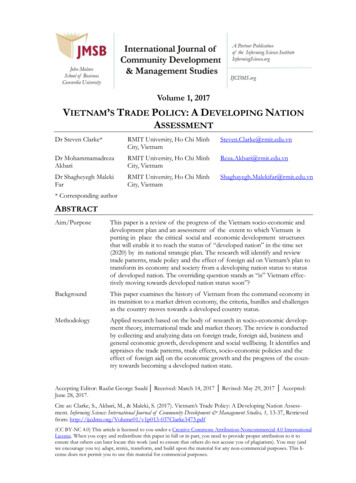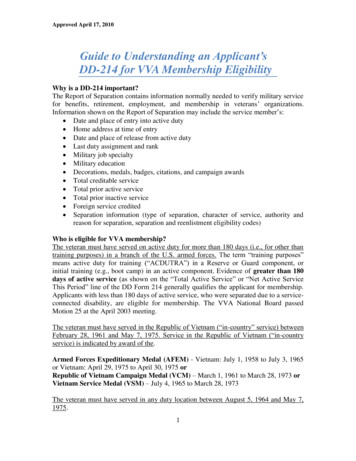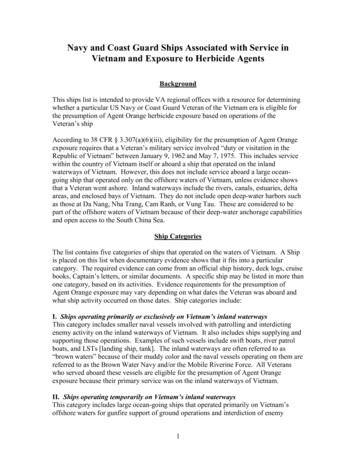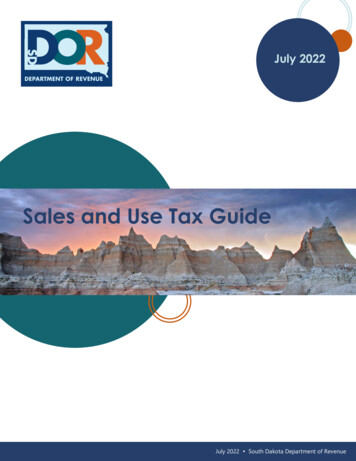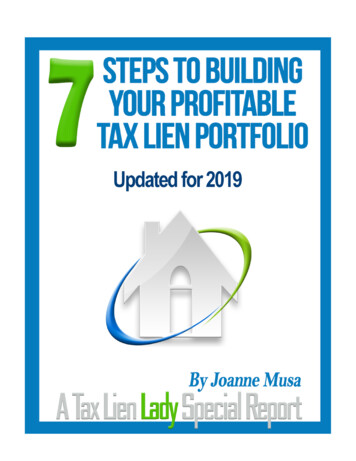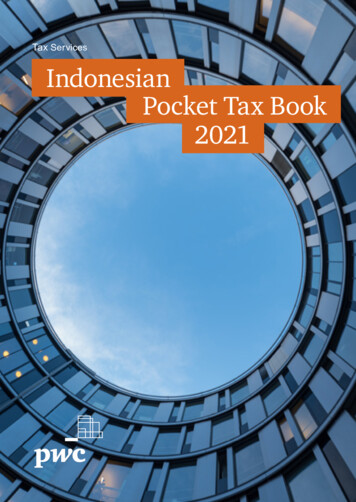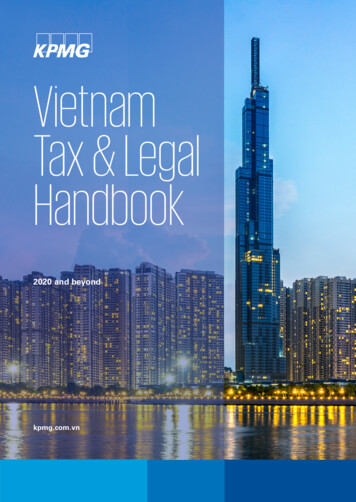
Transcription
VietnamTax & LegalHandbook2020 and beyondkpmg.com.vn
Table of ContentsForewordIntroductionTaxation07Tax Law in VietnamTax AdministrationCorporate Income TaxInternational TaxWithholding TaxInternational Tax AgreementsForeign Contractor TaxControlled Foreign CompaniesTransfer PricingNon-Resident Capital GainsIndirect TaxesValue Added TaxSpecial Sales TaxImport/Export DutiesEmployment TaxesSocial, Health and Unemployment InsurancePersonal Income TaxOther TaxesProperty TaxNatural Resources TaxEnvironment Protection TaxRegistration Tax (Stamp Duty)Commercial, Labour and Employment LawForms of Commercial PresenceRepresentative OfficeBranchLegal EntityInvestment IncentivesInvestment by way of Contractual ArrangementInvestment by way of Share/Capital Acquisition0328
Licensing Process and TimelineLabour and EmploymentRecruitmentLabour ContractNotice for TerminationWorking HoursAnnual LeaveSeverance AllowanceTrade UnionsVisa and Temporary Residence CardWork permitsBanking and Foreign Exchange ControlBank Accounts – Direct InvestmentBank Accounts - Indirect InvestmentForeign Exchange ControlProfit Remittance RegulationsLandIntellectual PropertyTypes of Intellectual Property Right Protected by Vietnam LawProtection of Intellectual Property RightsAppendices41Appendix 1 – Foreign Contractor Tax WithholdingAppendix 2 - International Tax Agreements for the Avoidance of Double TaxationAppendix 3 – Free Trade AgreementsAppendix 4 – Personal Income TaxAppendix 5 – Special Sales TaxAppendix 6 – Environmental Protection TaxKPMG in VietnamContact Us04
ForewordIt gives us great pleasure tointroduce the first edition ofKPMG Vietnam’s Tax & LegalHandbook.Dean RolfeTax PartnerKPMG Vietnamdrolfe@kpmg.com.vnSince major political andeconomic reforms introducedin 1986 under Doi Moi,Vietnam has developed as astrong and vibrant economyand is projected to become oneof the twenty largest globaleconomies by 2050. Currentlyit is one of the most dynamiccountries in Southeast Asia.According to recent WorldBank and IMF statistics,Vietnam achieved GDP growthin 2018 of 7.1% (6.8% in 2017)with government debt to GDPof 57.5% in 2018 (58.2% in2017) and inflation running atbetween 2% - 3% annually.This remarkable growth storyis supported by Vietnam’scontinued willingness toembrace global trade throughits membership into theWorld Trade Organisationin 2007 and its participationin numerous free tradeagreements. Vietnam signedthe Comprehensive andProgressive Agreement forTrans-Pacific Partnership on 8March 2018 which will resultin the removal of many taxbarriers. In addition Vietnamand the European Union signedthe EU-Vietnam Free Tradeagreement on 30 June 2019.This sets Vietnam apart fromits regional neighbours.05The information contained inthis 2020 Vietnam Tax & LegalHandbook is based on currentadministrative practice appliedto laws, decrees and circularsin force on 31 December 2019.Please note this handbookis limited in its scope andmay not include all relevantinformation. Accordingly anyinformation contained hereinshould not be relied uponwithout first obtaining separateindependent confirmationbased on individual facts andcircumstances.We hope you find this 2020Vietnam Tax & Legal handbookuseful.As the largest professionalservices firm in Vietnam,KPMG has prepared thisTax & Legal Handbook as anintroductory guide to doingbusiness in Vietnam. We hopeyour find this handbook helpfuland wish you every successwith your business endeavoursin Vietnam.
Currently itis one of themost dynamiccountries inSoutheast Asia.Dean Rolfe—06
Taxation
Tax Law in VietnamThe legislative framework of tax law in Vietnam is based on laws passed by the NationalAssembly of the Socialist Republic of Vietnam, as well as Decrees, Circulars and OfficialLetters issued by the Ministry of Finance (“MOF”), the General Department of Taxation(“GDT”) and/or local provincial taxation authorities (including customs authorities).A range of different tax laws exist in Vietnam which may seek to levy tax on assets,capital gains, turnover, profits or earnings. Withholding taxes also apply in a range ofcircumstances. Tax laws are supplemented by the Law on Tax Administration, whichregulates the administration elements of taxation in Vietnam.The following taxes may be applicable inVietnam: Corporate Income Tax (“CIT”); Foreign Contractor Tax (“FCT”); Value Added Tax (“VAT”); Special Sales Tax (“SST”) Customs duties; Personal Income Tax (“PIT”); and Employment taxes including, SocialInsurance (“SI”), UnemploymentInsurance (“UI”) and Health Insurance(“HI”).In addition, a range of other taxes may beapplicable in certain circumstances: Natural Resource Tax (“NRT”); Property Tax (“PT”);The territorial limits of Vietnamese taxationare hampered by loosely defined ruleson residency, source and the place ofsupply for the provision of goods andservices. The application of these tax lawsis of course subject to the application ofinternational agreements where relevant.Vietnam has also recently adopteda substance over form rule on taxadministration. The application of this ruleraises many questions and uncertainties asit was only introduced in 2019.Tax penalties for the incorrect paymentof taxes or duties are generally 20%of the primary tax not paid, plus a latepayment interest of 0.03% per day. Higherpenalties may be applied for cases of fraudor evasion. The statute of limitations isgenerally ten years. Where a taxpayer hasnot registered for tax there is no statute oflimitations. Environment Protection Tax (“EPT”); and Export Duties.08
Tax AdministrationVietnam has a consolidated tax administration law which contains statutory provisionsgoverning the administration of various tax laws including customs and personal incometax. However Vietnam has 64 autonomous regional provinces and each province has alocal tax authority which is responsible for the collection and administration of taxationfrom taxpayers registered within each respective province. Accordingly the administrationof taxation law in Vietnam is decentralised and this can and often results in differentadministrative practices, or interpretations of law.Taxpayers are required to register, file and pay taxes in the provincial location of theircommercial registration or place of residence. Taxpayers with multiple registered locations(e.g dependent or independent branches) will therefore be subject to tax administration bythe provincial tax authority in each separate registered location.Tax rulingsTax rulings may be requested by taxpayersvia an application to the relevant taxauthority. Ruling requests may be referredby the relevant tax authority to the GDTor the MOF. In some cases, the PrimeMinister of Vietnam may be called upon toconsider tax ruling requests.Tax audits and penaltiesTax audits are a feature of the Vietnamesetax landscape. Tax periods remain openuntil audited. Tax audits usually cover anumber of years and may cover a rangeof different taxes and are typically carriedout by the provincial tax authority wherea taxpayer is registered. The tax auditprocess is also subject to a range ofmandated procedural deadlines makingcompliance with the audit processchallenging especially when tax disputesarise.The GDT, the MOF and the State Auditoralso have the power to audit taxationmatters in specific circumstances.The tax administration law also containstax penalties for all sources of revenue.Briefly speaking, tax shortfalls identifiedduring the audit process may be subjectto a 20% penalty plus late paymentinterest of 0.03% per day. We notefor completeness that a tax penalty ofbetween 100% to 300% may be appliedto cases of fraud or evasion. On the otherhand, a voluntary disclosure of underpaid09tax will likely only attract late paymentinterest.Recent changes to the tax administrationlaw have included penalty protectionwhere taxpayers have followed officialguidance. The circumstances under whichthis penalty protection will be applied inpractice remains unclear however. It isalso unclear if this will apply to historicaltax shortfalls or tax shortfalls relating totax periods commencing on or after 1 July2020.Other considerationsThere is no general anti-avoidance rule inVietnam, but a substance over form rulehas been introduced with effect from 1July 2020.The tax authorities have broad powersto undertake tax audits of any taxpayer,withholding or customs agent. There is aten-year statute of limitations for tax auditsin Vietnam.Vietnam is not an OECD member and istherefore not bound by OECD guidelines.
10
Corporate Income Tax (CIT)The standard CIT tax year is the twelve-month period ending 31 December. A substituted(i.e., different) tax year-end may be adopted via an application process.CIT is levied on all companies (and other business activities) registered in Vietnam basedon worldwide income. Branches are also subject to CIT on any profits attributable to theVietnamese branch, although this is not usually applied in practice.CIT is typically collected from foreign enterprises (and foreign individuals) via theapplication of a withholding tax called Foreign Contractor Tax (refer below).Tax rates and tax incentivesThe standard CIT rate is 20%.Reduced CIT rates may apply in limitedcircumstances e.g., the education sector(10%). Conversely, higher CIT tax rates mayalso apply in other limited circumstancese.g., extractive industries like the mining orenergy sectors (32%, 50%).New investment projects or expansionactivities (which qualify for tax incentives)may be eligible for a temporary CIT ratereduction. Generally speaking eligibleinvestment activities or criteria may include: Geographic location; Sector-specific activities; or Investment size.More specifically, tax incentives may beavailable based on activities that are: Located in encouraged specialeconomic zones or areas with difficultsocio-economic conditions; or Sector specific activities includinghigh-tech, software, infrastructuredevelopment, environmental protection,health care, education, publishing,newspaper printing, social housing and/or afforestation; or New investment activities (projects)with large investment capital.Taxpayers must self-assess the applicationof tax incentives to their activities inaccordance with current tax regulations.It is worth highlighting that tax incentiverules have be subject to continuous11modification and are also subject todifferent administrative interpretationsby provincial tax authorities resulting ininconsistent application and interpretation.Tax incentives can also be withdrawn ifthe conditions or criteria applicable to taxincentives have changed. This may includea change in location or activity.A detailed description of tax incentivesis beyond the scope of this handbookand advice based on individual facts andcircumstances is strongly recommended.CIT returns and paymentsCIT returns are due on the last day ofthird month after fiscal year end. For a 31December year end this is 31 March of thefollowing calendar year.CIT is collected in a unified way for all CITpayers (excluding foreign contractors)and is not based on the size, turnover orcomplexity of the taxpayer. CIT is collectedas follows:Four (4) quarterly installments payable bythe 30th day following the end of eachquarter; andThe balance (if any) payable by the 90thday following year end.The law on how to calculate quarterlytax payments depends on whether thetaxpayer is required to prepare quarterlyfinancial statements or not.CIT may also become payable at differenttimes including for cessation of business.In such cases CIT is due and payable by
the 45th day following the relevant event.Late payment interest 0.03% (per day)may be applied if total tax payments for thefiscal year are not at least equal to 80% ofthe total tax liability due and payable forthe fiscal year. Employee welfare costs which exceednominated thresholdsCalculation of taxable profit Payment of taxes (including input VAT).Taxable profit is calculated by reference toaccounting profit (based on Vietnameseaccounting standards) after taxadjustments. Tax adjustments will includethe addition of other assessable incomeless non-deductible expenditure. Taxableprofit is also calculated by reference toworldwide income. Administrative fines and penaltiesCapital gains are included within taxableprofits.Non-deductible expenditureExpenses are non-deductible for CITpurposes if they do not meet certainsubjective tests including, but not limitedto, expenses which are not relevant to thebusiness of the taxpayer, do not providean economic benefit to the taxpayer or areconsidered to be duplicate expenses (e.g.management fees).The following (non-comprehensive) list ofexpenses may not be deductible for CITpurposes: Expenses not supported bydocumentation including transferpricing documentation (where relevant) Depreciation which exceeds nominateddepreciation rates Interest (exceeding 20% of EBITDA) Interest where registered chartercapital is not fully contributed Interest where the rate exceeds oneand a half times the relevant State Bankof Vietnam rate General accounting provisions(including inventory obsolescence andloss, bad or doubtful debts, warranties,employee entitlements etc) Employee remuneration which isnot documented in labour contracts,company employment policies or labouragreements Unrealised foreign exchange gains andlosses Donations and giftsTaxable permanent establishments(“PE”) in Vietnam may also be subject toadditional CIT expense deduction rulesincluding, but not limited to, the deductionof head office expenses allocated to theVietnamese PE.All expenditure is subject to a newsubstance over form rule with effect from1 July 2020.Other considerationsVietnam does not have a CIT consolidationor grouping regime, nor can accumulatedlosses be surrendered or transferred tomembers of the same corporate tax group.Accordingly profits and losses cannot beoffset between companies with commonownership.Tax losses may be carried forward andoffset against taxable income for fiveyears from the end of the year in whichthe tax loss arose. Tax losses may not becarried back and offset against profits inearlier tax years. There are no continuityof ownership, or continuity of businesstests applicable to the recoupment of carryforward tax losses.Eligible research and development(“R&D”) expenditure (capped at 10 percentof annual taxable profit) can be deductedfrom taxable profit. R&D expenditure mustbe reported to the tax authority annually aspart of the tax return filing process. EligibleR&D expenditure must arise from R&Dactivities conducted in Vietnam and mustbe substantiated by proper invoices andsupporting documents.Please note for completeness that differenttax rules may apply to certain industrieslike upstream oil and gas exploration,development and production.12
13
International TaxVietnam is not an OECD member and is therefore not bound by OECD rules. HoweverVietnam was the 100th jurisdiction to join the OECD’s Inclusive Framework on BaseErosion and Profit Shifting (“BEPS”) in June 2017. That said, Vietnam has not yet formallyagreed to adopt the OECD’s Multilateral Convention to Implement Tax Treaty RelatedMeasures to Prevent BEPS.Withholding Tax - dividends, interest, and royaltiesDividends, interest and royalties paid to non-residents are subject to domestic withholdingtaxes as follows:CategoryDomesticwithholding rateDividendsZeroInterest5%Royalties paid for the right to use or license patents, inventions,industrial property, designs, trademarks, copyrights and technicalknow-how (broadly referred to as the “transfer of technology”)10%These domestic rates of withholding taxare subject to the application of a doubletax agreement (refer below). Where aninternational tax agreement nominatesa lower rate of withholding tax and thedomestic treaty application process hasbeen adopted, the tax treaty rate can beapplied by the withholding agent.gains are realised by recipients who cannotevidence beneficial ownership, treatybenefits may be denied.Please also refer to Foreign ContactorTax (below) which applies in othercircumstances.In addition to the application of withholdingtaxes to the payment of dividends, interestand royalties, Vietnam also levies awithholding tax on numerous cross borderpayment arrangements. This expansivewithholding tax arrangement is referredto as ‘Foreign Contractor Tax’ (“FCT”) andis intended to collect Vietnamese CIT andVAT¹ from non-residents who supply or sellgoods and services into Vietnam.International tax agreementsWhile domestic tax laws are, in theory subjectto the application of international agreements,this is sometimes not applied in practice.The application of international taxagreements in Vietnam is also subject toa domestically imposed treaty applicationprocess and the application of internationaltax agreements may therefore be subjectto a five year limitation period (i.e., wherea valid treaty application has not beenmade). Integrity rules also exist in relationto beneficial ownership and treaty abuse.In situations where income is received orRefer to Appendix 2 for a list ofinternational tax agreements and specifiedwithholding tax rates.Foreign Contractor TaxThe regime applies to payments made tonon-resident enterprises or individuals whoare referred to as ‘foreign contractors’.It does not apply to a payment forthe importation of goods where thatimportation of goods is not accompaniedwith the provision of associated services(like installation or logistics services).VAT is also collected on the importation of goods into Vietnam via the customs declaration process. However VATon importation is calculated on the declared customs value, whereas VAT under the FCT regime is calculated on thepayment amount. Accordingly VAT may be collected twice on the same imported good.114
FCT comprises two elements, namely CITand VAT. The rates of withholding varydepending on the nature of the underlyinggoods or services imported into Vietnam.Contracts that combine different elementswith different rates of FCT withholdingmay give rise to complexities and adviceshould be sought. Refer to Appendix 1 forrates of FCT withholding.The primary FCT withholding obligationrests with the resident payor, unless thenon-resident foreign contractor has a taxregistration in Vietnam and has elected toself-declare and pay FCT. Non-residentforeign contractors can choose one ofthree different methods for the paymentof FCT as follows: Direct method; Deduction method; and Hybrid method.The key distinguishing feature betweenthese three different methods is theregistration and reporting obligationsimposed on the non-resident foreigncontractor.1. Direct methodThe simplest and most commonly appliedmethod is the direct method, wherebythe non-resident is not required to registerin Vietnam, but is instead subject to atraditional withholding tax arrangementcollected and remitted by the Vietnamesepayor. This method only applies where thepayor can act as a withholding agent.This is the default method and wouldapply regardless of any action, or inactiontaken by the non-resident foreigncontractor. That is to say, the complianceobligations associated with this methodrest entirely with the payor.2. Deduction methodThis method imposes registration andtax compliance obligations on the nonresident enterprise. Under this methodthe non-resident registers for VAT and CITas would be required for a local enterprise.It also results in CIT becoming due andpayable based on taxable profits at 20%.15Accordingly, this method results in theimposition of a significant CIT complianceand payment obligation and is rarelyelected in practice, but this method maybecome necessary in certain contractualsituations.3. Hybrid methodThis method is a combination of the directand the deduction method. That is to say,the non-resident enterprise is required toregister for VAT purposes and report andpay VAT according to normal domesticrules, but is not required to register andpay CIT. CIT would be collected underthe direct method as a withholding tax viathe payor.Controlled foreign company tax ruleVietnamese CIT rules described (above)include a defacto Controlled ForeignCompany regime by taxing the ‘income’of foreign subsidiaries if not remitted toVietnam in accordance with rules relatingto foreign investment.Attributed foreign income is subject toa 20% CIT rate even if the Vietnameseparent taxpayer currently enjoys aconcessional tax rate (say due to theapplication of a tax holiday). Where theforeign subsidiary has been subject toany foreign tax which is “similar” toVietnamese CIT, a foreign tax credit willbe available (in principle) to offset theVietnamese tax payable on the foreignsubsidiary’s income up to the level of theVietnamese tax payable on that income.The conversion of foreign income, gainsand tax credits into VND remains unclear.That is to say, it is not clear whether a spotFX rate is required on the transaction date,or whether a weekly, monthly or yearlyaverage can be adopted for currencyconversion purposes.Accordingly the attribution and taxation offoreign profits is complex and is subject toconsiderable uncertainty.Transfer pricingVietnam has detailed rules applicable totransfer pricing arrangements between
related parties. However, unlike otherjurisdictions, these rules also apply todomestic and foreign related parties alike.Vietnam is not an OECD memberand is not therefore bound by OECDguidelines but Vietnamese transfer pricingregulations broadly align with the OECDguidelines with certain unique localadaptations.Related party definitionIn principle, a related party is any entitydeemed to have control over anotherentity via common ownership (more than25% direct or indirect holding), or throughother arrangements as defined underthe law.Reporting obligationsTaxpayers who are subject to transferpricing rules are required to disclose arange of financial and non-financial dataas part of the annual CIT return. Theinformation to be disclosed is extensiveand preparation of the forms can berelatively complex.These forms are: Form 01 – Information on relatedparties and related party transactions; Form 02 – List of information,documents required in Local File; Form 03 – List of information,documents required in Master File; and Form 04 – Country by Country report(only applicable to Vietnamesemultinational group).These forms are required to be submittedalong with the annual CIT return on orbefore the 90th day after tax year end. Fora 31 December year end this is 31 Marchof the following calendar year.Documentation obligationsIn addition to the above-mentioneddeclaration process, Vietnam requiresthe maintenance of a Local File, MasterFile and Country-by-Country reportunless exempted (refer below). That isto say, a three-tiered documentationapproach is required in Vietnam and suchdocumentation must be maintained inVietnamese and retained locally. Careshould be taken to ensure transfer pricingdocumentation meets local requirements.Similarly, for declaration requirements(above), transfer pricing documentation isalso required to be prepared on or beforethe 90th day after tax year end. It is alsorequired to be submitted upon the requestof a tax authority.A taxpayer is exempted from transferpricing documentation requirements in thefollowing circumstances: Revenue below VND50 billion ANDrelated party transactions belowVND30 billion; or Has an Advance Pricing Agreement(“APA”) and has submitted the annualAPA report in accordance with the APAregulations; or Revenue below VND200 billion andperforms simple functions and meetsnominated profit ratios.Documentation including benchmarkinganalysis must be updated on an annualbasis.Penalties and interestWhere a taxpayer is deemed to benon-compliant with the transfer pricingreporting and documentation obligations,the tax authorities have the right to usesecret comparables to make transferpricing adjustments.A transfer pricing adjustment that resultsin additional CIT may be subject to apenalty of 20% tax shortfall penalty pluslate payment interest.Methodology considerationsComparable uncontrolled price,resale price, cost plus, profit splitand comparable profits method arepermissible. However, Vietnam does notallow a lump sum or year end downward‘transfer pricing adjustment’ as this maybe subject to challenge. Accordingly a‘transfer pricing adjustment’ may resultin a transfer pricing dispute and a nondeductible expense for CIT purposes.16
This issue is extremely controversialand remains an area of considerableuncertainty. Advice should be sought onthe local implementation of global transferpricing policies.Non-resident capital gains taxrules are different depending onwhether the Vietnamese companyis defined as Public or Non-publicpursuant to Law on SecuritiesNon-publicCapital gains realised on the direct(or indirect disposal) of shares in aVietnamese incorporated and tax residentcompany by a non-resident are consideredto be taxable in Vietnam pursuant todomestic tax law. This position is subjectto the application of an International TaxAgreement. The tax rate applied to anyrealised capital gain is 20%.There is currently no group roll-over reliefand all transfers remain subject to tax.Numerous proposals to modify theserules have been announced and arecurrently under consideration.The capital gain is calculated by referenceto consideration paid less the cost baseof the shares. The cost base of the sharesis usually calculated by reference to thecontributed share capital (called chartercapital), however complexities may arisewhere a previous share transfer hasoccurred resulting in a different cost basevalue for the current owner. Considerationis required to be calculated by referenceto a market value consideration and isusually documented via a share purchaseagreement. It should be noted thatinternal group reorganisations and othertransaction forms (e.g. share for shareexchanges) may give rise to a range ofadditional issues including valuationconsiderations.When the vendor is a non-resident, theVietnamese company is required toreport and pay the capital gains tax onbehalf of the non-resident. The timing ofthese reporting and payment obligationsvaries depending on the nature of the17transaction, but is likely to be either tendays after the parties conclude legaldocumentation (e.g., a signed sharepurchase agreement), or ten days aftergovernment approval has been obtainedwhere such approval is required.Any treaty claim made by or on behalfof a non-resident (in relation to a treatyprotected capital gain) must be made via aseparate treaty clearance process.When the vendor is a Vietnamese taxresident, the Vietnamese company beingtransferred is relieved of these reportingand payment obligations.Listed securities-PublicThe disposal of securities (shares in publicjoint stock companies and certain bonds)by non-residents are subject to capitalgains on a deemed basis. The tax payablein such situations is calculated as 0.1% ofthe consideration received and is retainedand remitted to the relevant tax authorityby the purchaser.In contrast, the disposal of securities byresidents remains subject to tax at 20% ofthe realised capital gain.
Indirect TaxesVietnam levies a range of different indirect taxes, duties and fees on many differenttransactions as follows.Value Added TaxValue Added Tax (“VAT”) is a broad-based taximposed on most goods, services and otheritems sold or consumed in Vietnam. Vietnamadopts a traditional VAT system whereimported goods and services are subject toVAT, whereas exported goods and servicesare not subject to VAT in most cases. As aresult, the supply of goods and services issubject to VAT at nominated rates of tax,unless otherwise exempted (or zero rated).VAT calculationVAT is generally calculated as follows: VATpayable Output VAT - Input VATOutput VAT is calculated as the taxable value(sales price) of VATable goods or services soldor supplied multiplied by the relevant VATrate. Input VAT is calculated by referenceto VAT paid on the purchase of goods andservices and is documented via invoices. Thismethod of calculating VAT is referred to as thededuction method.Taxpayers with annual revenue below VND1 billion, may elect the direct method whereVAT is calculated and paid on the taxable value(sales price) of VATable goods or services soldor supplied multiplied by the relevant VAT rate.No input VAT is credited against output VAT.This method of calculating VAT is referred toas the direct method.sporting services, social housing and othervarious goods and services.An output VAT rate of zero (0%) applies tothe export of goods and services whichare consumed outside Vietnam. A zero ratemay also apply to the supply of goods andservices into a domestic export processingzone. However it is worth highlightingthat the meaning of consumed outsideVietnam is not clearly defined and remains acontroversial issue.Input VAT is collected as described belowExported goodsExported goods are zero rated allowing inputVAT to be credited against output VAT orrefunded in certain situations and providingnumerous conditions have been satisfied.Exported servicesVietnam does not have a place of supplyrule which is used to determine or identifywhen a service has been exported orwhere it has been supplied. Instead, it isnecessary to assess whether the serviceshas been “consumed” outside Vietnam. Nostatutory guidance is provided in respectof the place of consumption, althoughvarious official letters have been publishedaddressing particular factual circumstancesfor individual taxpayers.VAT rateVAT is levied on the supply of most goodsand services in Vietnam at the standardoutput VAT rate of 10%.Exported services, which are considered tohave been consumed outside Vietnam maybe zero rated. This allows input VAT (i.e.,paid on the purchase of goods and services)to be claimed as an input
the total tax liability due and payable for the fiscal year. Calculation of taxable profit Taxable profit is calculated by reference to accounting profit (based on Vietnamese accounting standards) after tax adjustments. Tax adjustments will include the addition of other assessable income less non-deductible expenditure. Taxable
